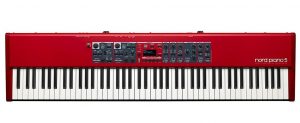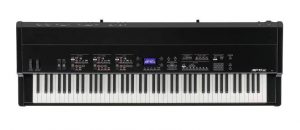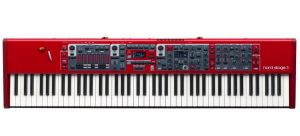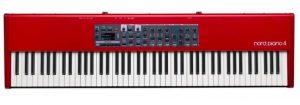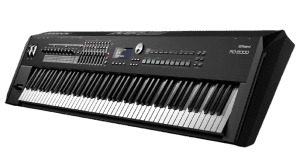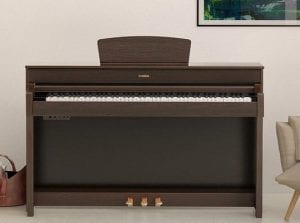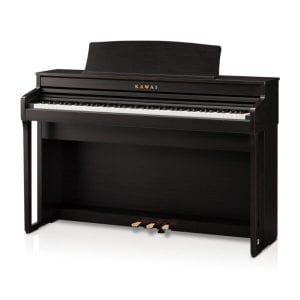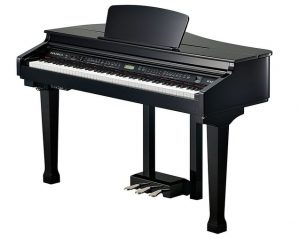After practicing and playing pianos for a few years, you have finally come to the point of buying a piano for $5000. Experts and advanced piano players should definitely buy a piano that has all the intricate features to complement their playing styles, even if the cost of these pianos is slightly at the higher end.
We have attempted to make your search simpler by listing the top 9 best digital pianos under $5000 from the leading brands. We have also elaborated on the unique features of these pianos to aid you in your buying choice. We understand that buying a new piano can be a lengthy process with lots of undisclosed questions. And we hope our guide helps you in picking up the right piano for your practice and performance.
Quick Summary: Best Digital Pianos Under $5000
Table of Contents
- Top 9 Best Digital Pianos Under $5000
- 1. Nord Piano 5 Digital Piano– Best Overall
- 2. Kawai MP11SE Professional Stage Piano – Incredibly Responsive
- 3. Nord Stage 3 Digital Piano – Editor’s Pick
- 4. Nord Piano 4 Stage Piano – Complete Package
- 5. Roland RD-2000 Premium Digital Stage Piano – Best Sound Quality
- 6. Yamaha CP88 Digital Stage Piano – Great Choice Under $5000
- 7. Yamaha Arius YDP-184 Digital Piano – Best for Beginners
- 8. Kawai CA49 Grand Compact Digital Piano – Good Alternative Under $5000
- 9. Kurzweil Home KAG100 Digital Piano – Grand Piano Under $5000
- What to Look For Your in Your Digital Piano When You Spend $5000 on it?
- Our Recommendation
- Difference Between Regular and Digital Pianos
- If Needed, What Training Should Be Taken Up For Playing A Digital Piano?
- How To Measure Performance and Sound?
- Technical Help For Setting It Up
- You Might Also Like
- Frequently Asked Questions (FAQs)
- 1. Some Important Tips for Beginners of Digital Piano.
- 2. Why Does One Prefer Acoustic Piano?
- 3. Why Should We Buy a Digital Piano?
- 4. Which Type of Piano is Better to Learn?
- 5. How Many Keys Should a Beginner Learn?
- 6. What is MIDI Compatibility?
- 7. What is a Synthesizer Digital Piano?
- 8. How Does Hybrid Piano Work?
Top 9 Best Digital Pianos Under $5000
1. Nord Piano 5 Digital Piano– Best Overall
Check Price on Online Stores:
This is one of the excellent digital pianos under $5000 with an adjustable stand, sustain pedal, expression pedal, instructional DVD from Austin Bazaar, and a cleaning cloth. The piano features an 88-note triple sensor keybed with a grand weighted action and the piano also features virtual hammer action technology from Nord. The piano features an advanced KB SPlit with optional crossfades and the piano features reverb with Chorale features along with dark and bright modes. The piano comes with a complete set of accessories and offers everything that you require to start playing the instrument immediately.
The piano comes with an adjustable stand so that one does need not to purchase a separate stand. The piano features an expression pedal so that the pianist can control their modulation, volume, and delay levels appropriately. The piano also comes with a sustain pedal, so that the pianist can enjoy a smooth playing experience. The Austin Bazaar instructional DVD that comes with the piano helps the pianist to pick up tips and instructions to learn to play the piano instrument. The Austin Bazaar polishing cloth helps in maintaining the instrument in exceptional condition.
These award-winning pianos are equipped with dual piano engines, and dual sample synths, along with twice the memory of the previous generation pianos. The piano offers a perfect combination of a premium triple sensor keybed and the exclusive virtual hammer technology of the piano delivering an exceptional playing experience. The instrument features two independent pianos and sample synths and they can be used simultaneously in a range of layer and split configurations. The piano is combined with versatile effects along with a range of combinations that can be achieved from classic ensemble settings to rich soundscapes.
What’s Best in Nord Piano 5?
- The unique virtual hammer action technology of the piano delivers outstanding authenticity resulting in dynamic keyboard actions
- The dynamic keyboard action of this piano offers tremendous control at all velocity levels.
- The triple-sensor keybed ensures fluent transitions and smooth repetitions.
- There is a soft-release mode that offers a slightly longer release for legato playing.
What’s Lacking in Nord Piano 5?
- Its sample memory is only 256 MB.
Check Out: Best Yamaha Digital Pianos
2. Kawai MP11SE Professional Stage Piano – Incredibly Responsive
Check Price on Online Stores:
The Kawai MP11SE is one of the best professional digital pianos of the year and is one of the most authentic pianos with the most reliable sound and articulate controls in its class. The MP’s series of professional-grade pianos are recognized all over the world for their exceptional tone and great performance.
The piano renders a grand feel and an exceptional wooded keyboard action for crafting masterpieces in piano tunes. There is also an exceptional MIDI controller and a careful collection of grand piano sounds in this professional stage piano. The Kawai MP11SE is a great stage piano for musicians who will never accept compromise in their music journey.
Apart from the wooden keyboard action, which recreates the natural feel and motion of an acoustic piano, the instrument also features an intuitive interface with independent sound effects. The piano also includes a wide selection of electric piano sounds and other subsidiary sounds, which makes MP11SE a great option for serious pianists. The instrument also features a strong 4-channel MIDI master controller and a triple pedal unit, to add to its existing list of impressive piano features.
The tones of this piano are worth mentioning as it includes the magnificent tone of the world-renowned Shigeru Kawai SK-EX Concert grand piano. These are indeed exceptional elements for an extraordinary piano stage performance for music professionals who seize to compromise on piano performance. The piano features the best selection of electric and other piano sounds and also features a variety of virtual technician sound editing parameters.
What’s Best in Kawai MP11SE?
- The piano features stunning acoustic grand piano sounds of the SK-EX, SK-5, and EX pianos.
- The piano includes a GFP-3 triple pedal unit that is manufactured by Kawai.
- It features a new and improved sturdy metal chassis with black polish wooden sidearms.
- The piano features triple sensor detection along with ivory touch key surfaces
- The instrument features a strong selection of realistic sounds from electrical pianos.
What’s Lacking in Kawai MP11SE?
- There are no internal songs or lesson modes on this piano.
- There are no Bluetooth connectivity or app functions.
3. Nord Stage 3 Digital Piano – Editor’s Pick
Check Price on Online Stores:
The best feature of the Nord Stage 3 digital piano is that the instrument features three sound-generating sections, namely the organ, piano, and Synthesizer, that can be used simultaneously. Also, the Nord Stage 3 digital piano features two separate slots that allow the users to have 2 pianos, 2 synths, and 2 organs along with Effects at the same time for exceptional sound flexibility.
The Nord Stage 3 piano also features three split zones and new split crossfade functionality. There is also a new split point editor mode, that allows the pianist to easily organize and set up the split point, by making use of the OLED display. The piano also supports program change through its pedal, allowing for flexible program changes, while keeping the hands at the keyboard.
The Nord Stage 3 digital piano features a grand selection of electric pianos, digital pianos, uprights, harpsichords, clavinets, etc, from an exclusive Nord Piano library. The piano also features a brand new layer category with rich and dynamic layered patches. Its state-of-the-art sampling technologies help in capturing great nuances and real music tunes of the source instruments. Its advanced string resonance and dynamic pedal noise features deliver breathtaking realism and an exceptional level of expressiveness. The Nord Stage 3 digital piano features the latest generation of the vintage 122 rotary speaker simulation, adding an important character to the live organ performance shows.
The Lead A1 synth engine is renowned for its analog-modeling warmth and makes use of smart oscillator configurations to deliver stunning results with minimal programming. The Synth section also renders three unison modes, without mitigating voice polyphony. The piano features an elaborate effect section. The Nord Stage 3 Effect section features a new filter effect, enhanced delay effect, and morphable parameters, along with a separate reverb and compressor for each of the slots.
What’s Best in Nord Stage 3?
- The Nord Stage piano features a fully weighted hammer action keybed with a portable keybed.
- The Nord Stage 3 compact piano features a 73-note semi-weighted waterfall keybed with physical drawbars.
- It’s compact 73-key keybed is perfect for mobility, and its semi-weighted keys are wonderful to play with.
- Its mod wheel is extremely handy and can be assigned to any function. It is useful for volume control and organs for live performances.
What’s Lacking in Nord Stage 3?
- There are no built-in speakers on this piano. We can plug in the headphones, however.
4. Nord Piano 4 Stage Piano – Complete Package
Check Price on Online Stores:
This is an excellent piano with a 512 MB sample library memory. This piano features an 88-note triple sensor key bed with a grand weighted action, to render authentic piano touch and feel. The virtual hammer action technology enables the users to produce a new note without having to lift the key for smoother repetitions. The piano helps in seamless transitions while changing programs and sounds while playing the piano.
The piano features an excellent OLED display and its enhanced organize mode includes, copy/paste and move functionalities to arrange the diverse programs in the device quickly. The page view feature in this app helps players to sort pages to revise their favorite song list. There is also a numeric pad in this piano to help with direct program access.
This is an award-winning piano that offers an expanded voice polyphony, a premium triple sensor keybed, and a virtual hammer action technology for an ultimate piano experience.
The Nord Piano 4 also features many brilliant features such as seamless transitions, dedicated piano filters, etc., for an exceptional piano feel. The piano also has dedicated knobs and buttons to accomplish all essential functions and live performance functions.
There is an optional numeric pad mode that renders instant access to programs, by entering the program number. Its enhanced piano selection features open gates for ambient acoustic, digital, and electric pianos along with its expanded sound library and extended voice polyphony.
What’s Best in Nord Piano 4?
- The piano renders high-quality stereo effects
- All the piano effects can be assigned freely to the piano and sample synth section.
- The piano comes with a Nord triple pedal
- This piano comes with a triple pedal.
What’s Lacking in Nord Piano 4?
- The very heavy piano weighs around 56 pounds.
5. Roland RD-2000 Premium Digital Stage Piano – Best Sound Quality
Check Price on Online Stores:
This is an excellent digital stage piano from the legendary Roland brand that comes at an affordable cost of less than $5000. The purchase includes a digital stage piano, owner’s manual, damper pedal, power cord, and a piano stand. The piano can be slightly heavy as it weighs around 47 lbs and thus might require assistance for assembling and carrying around. The piano features a graphic LCD that measures around 256 x 80 dots and this weighted keyboard features 88-note hammer action keys to adjust the keys to different line voltages.
The piano features an excellent sound engine with 128-note voice polyphony for electric pianos and additional sounds that are compatible with RD-800 live sets. This is a next-generation RD stage piano that features two independent sound engines, modern controller features, and eight knobs with LED status indicators. The piano also has nine sliders for real-time control of sounds and piano effects.
This is a dedicated acoustic piano with the revolutionary Roland sound engine, to render authentic tunes with full polyphony. This is a classic electric piano on board that includes the legendary RD-1000 and MKS-20 sound engine. This keyboard features a molded construction for premium touch and lasting durability. There are eight assignable zones for combining the internal sounds and external sources
What’s Best in Roland RD-2000?
- The piano is equipped with independent sound engines, premium action, and advanced controller features.
- The RD-2000 has a dedicated acoustic piano sound engine with a detailed tone for polyphony.
- This is a gorgeous acoustic piano that is powered by V-piano technology
- The Roland RD-2000 digital piano has been designed for the stage.
What’s Lacking in Roland RD-2000?
- There is no Bluetooth feature to connect with wireless headphones.
- It features only a single pedal for sostenuto.
6. Yamaha CP88 Digital Stage Piano – Great Choice Under $5000
Check Price on Online Stores:
The Yamaha CP88 is an absolute evolution of stage pianos that possess the qualities of premium concert grand pianos. The highlight of the keyboard is the 88 natural wooden keys along with ivory keytops, synthetic ebony, and graded hammer action. The highlight feature of this piano is its powerful bass and sparkling heights that render the strength to conduct a complete orchestra. The flawless natural wood exteriors and the triple sensor feature offer this piano the look of a grand piano.
The unique feature of CP88 is an amazing grand piano that delivers crisp, sparkling, and robust bass along with dynamic range sounds. The reverb, master delay, and EQ effects with real-time controls are amazing to use. Yamaha CP88 offers complete dynamic expression and develops an integrated effect and extensive section for developing your unique, own sound.
The CP88 features rich synth sounds for any music session. The CP88 grand piano features integrated and extensive piano effects to create one’s own unique sounds. There are also master effects in this piano with dedicated controls for easy and real-time tweaking.
Its virtual circuitry modeling technology recreates the behavior and sounds of high-end signal processors and its natural wooded keys will offer the weight and the response that the piano players experience. The keyboard will recreate the rich feel of the piano hammers, and the keys are surely heavy at the low end and light at the higher end. Its synthetic ivory and ebony keys are slightly porous, adding more grip to the keys. There is also a third sensor in this piano that allows key repetition in the grand piano and articulates it efficiently without a complete release.
What’s Best in Yamaha CP88?
- This piano has over 128 voice polyphony and an AVM2 tone generator
- The piano comes with an FC3A sustain pedal and an NW-GH triple sensor.
- It comes with a free pair of Samson SR950 professional studio reference headphones.
What’s Lacking in Yamaha CP88?
- There are no built-in speakers with this piano.
Also Check: Best Digital Pianos Under $2000
7. Yamaha Arius YDP-184 Digital Piano – Best for Beginners
Check Price on Online Stores:
The Yamaha YDP 184 is a flagship model of the Arius series sounds extraordinary with its CFX grand tunes and renders the freedom for the pianist to create distinct tunes. The Yamaha YDP 184 is a flagship piano that recreates the tone and power of its CFX concert grand piano. It features an eminent LCD display to help with smooth navigation of the functions and features of the instrument. This piano has a number of functions including intelligent acoustic control, acoustic optimizer, and stereophonic optimizer.
The piano has a monochrome LCD screen above the controls on the left panel and makes modification of settings and navigation across the keyboard much better. A three-pedal setup is built into the piano and even the soft and the damper pedals have detailed sensors built into them. The Virtual Resonance Modeling feature of this piano resonates with the string sound of each of the 88 keys of this piano, along with the timing and depth of the damper pedals to create rich music with vivid expressions.
The Piano room is an extremely user-friendly software that helps the pianist to alter a number of parameters to shape the sound as they desire. Its reverb unit includes a lot of new algorithms that include the concert hall, recital hall, club, plate, chamber, and cathedral. The YDP 184 features the Graded GH3 key bed with plastic keys covered with ivory and ebony keytops. The YDP 184 comes with a metronome, which is the basis for practicing the piano with time and rhythm sense.
What’s Best in Yamaha Arius YDP-184?
- This is a well-designed piano with solid construction
- Features excellent GH3 action keys
- There is a diverse range of sample sounds and inbuilt tunes
What’s Lacking in Yamaha Arius YDP-184?
- This piano has very limited connectivity features.
Also Check: Best Digital Pianos & Keyboards for Beginners
8. Kawai CA49 Grand Compact Digital Piano – Good Alternative Under $5000
Check Price on Online Stores:
This is an expert piano with a bench, from the legendary Kawai brand and looks grand and elegant, as it is made from premium rosewood material. It s a grand feel compact digital piano that comes with a matching bench and an AC power adapter. The piano also comes with a five-year limited warranty. The motherboard of this piano has been developed in partnership with Onkyo for enhanced tonal clarity. Its updated control panel is featured a modern OLED graphic display and its tone control settings feature eight-tone presets.
The Kawai CA49 88 is the successor to the popular CA48 digital piano and it features an authentic sound and many premium features. This digital piano incorporates diverse technologies that have been developed in collaboration with rich audio equipment manufacturers. Its intense amplification system has been designed to deliver high-quality and rich sound.
This piano model preserves the features of the Kawai EX concert grand pianos and the Kawai SK-EK grand piano to deliver a more natural and realistic playing experience. Its new volume balance function helps to improve consistency while playing at low volume levels.
This CA49 digital piano features an updated cabinet design and adopts a taller body and a rounded edge for an impressive and premium music-playing experience. The piano also features a cheek block control panel and a modern OLED graphic display for easy and elegant operation. The Kawai CA (concert artist) series is one of the most award-winning lines of digital pianos that are available in modern times and are capable of rendering a premium piano-playing experience.
What’s Best in Kawai CA49?
- Features compact keyboard action that incorporates 90 years of acoustic piano craftsmanship.
- Features 88 black and white keys, that are made entirely from long wood pieces with finely textured ivory.
- The piano renders the most beautiful sound, and gorgeous look, and is absolutely fun to play with.
What’s Lacking in Kawai CA49?
- The piano has fewer instrument sounds.
Check out: Best Digital Pianos for Advanced Pianists
9. Kurzweil Home KAG100 Digital Piano – Grand Piano Under $5000
Check Price on Online Stores:
The KAG-100 digital grand piano features an 88-note keyboard with fully weighted keys, that is capable of sustaining 64 voices at a time. The pianist can choose from over 200 different sound selections such as orchestral instruments and organ sounds, to enhance musical creations. Its expressive 88-note keyboard can sustain up to 64 voices at a time. Its selective keyboard sensitivity renders a selectable keyboard sensitivity to render an authentic grand feel under the fingers.
It’s built-in soft, sustain, and sostenuto pedals help in adding a final piece of realism to make the piano feel and play with spirit and elegance, along with the sensitivity of a truly acoustic grand piano. There are about 71 demo songs and 55 learning songs to brush up on the skills. The Bluetooth capability of this piano allows the pianist to connect with a tablet or smartphone to play along the backing track of choice. The vivid display control panel in the middle of the keyboard allows the piano to control all these elements. You can make quick voice changes and also switch to the metronome and the transpose functions.
There are 100 styles of auto-accompaniment features that offer completely orchestrated backing arrangements, 8 chorus types, and 8 reverb types. The piano also features Bluetooth wireless support and a powerful 20W and 15W four-speaker stereo sound system, along with a matching bench.
What’s Best in Kurzweil KAG100?
- The piano features 88-key fully weighted keyboard sounds and feels like an acoustic grand piano
- The built-in speakers offer crisp and clear audio.
- The piano is both USB and Bluetooth compatible
- There are hundreds of demos and learning songs for easy practice
- There are three pedals in this piano, namely soft, sustain, and sostenuto pedals.
What’s Lacking in Kurzweil KAG100?
- The piano doesn’t have general MIDI features.
- The maximum polyphony in this piano is only 64.
What to Look For Your in Your Digital Piano When You Spend $5000 on it?
The world of digital pianos can be confusing and overwhelming not just for novice players, but also for experts. The following are the important aspects that one should consider before investing $5000 in their digital piano.
- Buy a piano that is capable of replicating the sound and feel of an acoustic piano realistically.
- Make sure the strings, keys, and hammers of the digital piano are able to reproduce the sounds of the corresponding instrument.
- Make sure the piano has expert sound sampling technology as has samples at different velocity levels, to respond to the key presses naturally.
- Make sure the keys are weighted and follow a hammer action to recreate the sounds of an acoustic piano.
- Choose a portable piano so that you can flaunt your piano-playing styles on diverse stages.
In case you need a piano for home: Best Home Digital Pianos
Our Recommendation
We have listed the best digital pianos under $5000 here that are on par with the famous acoustic pianos of the world. These pianos are great in look, touch, and sound and are definitely worth the investment, and are capable of escalating your piano skills to great levels.
Related:
Difference Between Regular and Digital Pianos
Since the beginning of the 18th century, acoustic pianos were in use. But in all that time, their basic structure hasn’t altered or changed all that much. But in order to enhance the feel and acoustics of pianos, changes have been made to key lengths and cabinet sizes. But generally speaking, most manufacturers have not found the need to significantly update a classic design and sound.
A genuine piano generally has 88 keys, giving you access to an incredible 7-octave note range. This can be a crucial feature if you’re a pianist with classical training. Playing extremely low or high notes may be important as you become more accustomed to performing challenging musical compositions.
Acoustic pianos have been replaced by digital pianos as more contemporary pianos. The digital piano is an invention that only recently gained widespread acceptance since it includes electronic circuits and needs electricity to function.
Digital pianos are played exactly the same as their acoustic counterparts since they have the same set of keys. Digital pianos, however, may be found in a wide range of styles, dimensions, and features.
There are many different types of digital pianos available, ranging from tiny and portable 61-key instruments to large-scale 88-key instruments. Many include user-friendly interfaces and settings that let you access and modify a huge variety of piano sounds, making them quite adaptable.
If Needed, What Training Should Be Taken Up For Playing A Digital Piano?
- Understand your instrument: This guideline still applies to you even if you are not just beginning to play the piano. Knowing your instrument or tool is the first and most crucial condition for playing any instrument or using any tool. You must have a working understanding of your digital piano in order to study or play the piano.
- Recognize the pattern: You need to be familiar with every key on your piano’s keyboard and the order in which they are arranged. Each digital piano has a set of black and white keys that are arranged in a specific way.
- Play an octave: An octave is a set of eight notes, such as B to B or C to C, for example. Learn to play octaves and become familiar with various scale types.
- Watch your intervals: Timing and intervals are crucial for beginners, and over time, your fingers will become accustomed to them. On the piano, you must be aware of where your fingers are traveling and maintain concentration.
- Practice hand dynamics by playing the piano with a variety of hands.
- Discover chords: It will be challenging to play chords at first, but with practice, you will become an expert.
- Hire a knowledgeable trainer: When selecting a piano instructor, keep in mind that he must have the expertise and education to impart to you all the principles of this instrument.
- Start your education by listening: Try to play recorded music and listen to it at the same time. You will soon be able to learn the keys to play by playing. Before beginning to play a song, you can take two or more notes on it and divide it into two or smaller portions. Nowadays, a lot of pianos come with on-screen finger guidance, which is incredibly helpful for performing songs correctly. Even some tunes can be learned and played.
- Change your tone and style when practicing and performing. You shouldn’t limit yourself to one particular tone or style.
- Have fun playing: Your fingers will naturally press the right keys after you love playing something and become comfortable with it by playing it again.
- You must put in around 20 to 25 minutes of diligent practice each day. Work on various scales and chords. Find the music sheet for some fresh songs online and download them for practice. You may choose from a wide variety of music, both easy and difficult. Make your choice based on your degree of knowledge. Avoid overstressing yourself by choosing more difficult ones while you are still learning the fundamentals.
- Increase levels gradually when you have mastered one speed or tempo. Allow a level some time because it will require some adjustment for your hands to work at that speed.
- When you want to play by yourself, digital pianos offer a headphone jack that you may use. You may still enjoy practicing by yourself even when there are other people around.
- Recording tunes on a piano is another benefit that even a cheap piano can provide. You may tape your practice sessions, listen to them afterward, and note any errors or areas that need development.
How To Measure Performance and Sound?
The vibration that results from a piano hammer striking a string produces thousands of partials (vibrating string segments resembling miniature strings), each of which follows a different pattern in time (the next few seconds). In order to precisely represent 5 seconds of the middle C on graphs printed on A4 sheets, we need a belt of nearly 300 miles of sheets adhered one on top of the other. The human ear can hear all of this information.
Technical Help For Setting It Up
- Digital pianos are far more resilient than acoustic pianos and are not affected by variations in humidity or temperature. They may thus be placed just about anywhere, including next to a radiator or beneath a window. However, you should keep the cabinet out of direct sunlight to prevent fading, and keep it out of an area where it must share a plug with another electrical device to prevent interference. Naturally, you also want to place your keyboard in a location that inspires you to play. Look for a location that is simple to access, has plenty of room for elbows, and has decent lighting.
- The sound of a piano will be affected by the surroundings and the furniture in it. For instance, a hardwood floor will make the sound more lively or reverberant, whereas a thick carpet would deaden it.
- You may get around this with many digital pianos by adding reverb or brightness to the sound to suit your preferences. Some even let you adjust the sound note by note, which is perfect if you have furniture or a place where particular frequencies might predominate, like bass frequencies, which can make the piano sound bass-heavy and midrange frequencies.
- Place both of your feet firmly on the floor and sit on the front edge of the stool. You are seated at the proper distance if you can easily touch both sides of the keyboard with only a tiny sense of strain in your chest. A cushion will do if an adaptable stool is not available; just make sure your forearm and wrist are in a straight line.
- Last but not least, turn off your digital piano when not in use. This is for energy efficiency reasons rather than any potential for long-term harm. A function called auto-off on some digital pianos turns the instrument off after a predetermined amount of inactivity.
Also Check: Best Digital Pianos Under $3000
You Might Also Like
- Best-Selling Digital Piano Yamaha DGX 670 Review
- Top Synthesizers Korg Krome EX Workstations Review
- Best Affordable Digital Piano: Roland FP10 Review
- Korg D1: Best Digital Piano Review
Frequently Asked Questions (FAQs)
1. Some Important Tips for Beginners of Digital Piano.
By practicing with the available rhythms on your piano, you may improve your timing and tone. If you can, enroll in piano lessons since they will be more beneficial. It is usually preferable to get advice and fundamental information from experts. Pay attention to your teacher and absorb his knowledge. Although it is not required, you can also reference books and movies. Take constructive criticism to heart and work on your weak points.
2. Why Does One Prefer Acoustic Piano?
In general, classical pianists who demand nothing less than the real thing will be drawn to acoustic pianos. Nothing is wrong with it, either! Real grand pianos are also preferred by many recording studios because they allow sound engineers to record the ambiance of the space in which the piano is being played. As a result, an ambiance is created that can make a recording sound more three-dimensional.
3. Why Should We Buy a Digital Piano?
The sounds that a digital piano generates are samples of pianos that were properly tuned to accuracy. Therefore, tuning will never be an issue with a digital piano wherever you play. As opposed to acoustic pianos, which are sometimes out of tune due to variations in humidity or temperature, you can rely on the fact that your sound will always be constant.
4. Which Type of Piano is Better to Learn?
Digital pianos are thought to be better learning tools for beginners. This is due to both their accessibility and the variety of connectivity possibilities they offer. You can attach headphones to the outputs of digital pianos, as we briefly mentioned previously in the essay. You may therefore exercise in silence without bothering your neighbors.
5. How Many Keys Should a Beginner Learn?
Although 88-key digital pianos are the greatest option for pupils hoping to study classical piano, they can also start out with a 66-key model. And the cost isn’t the only factor to take into account—instruments with 66 keys are typically less expensive.
6. What is MIDI Compatibility?
A widely used electronic device language that enables instruments to “speak” to one other by transmitting and receiving signals, MIDI stands for “musical instrument digital interface.” While MIDI compatibility is not a must for a music keyboard for novices, it can become more significant to the student if they start playing electronic music or decide to connect the piano to a computer.
7. What is a Synthesizer Digital Piano?
A synthesizer is a common music keyboard for amateurs that can produce a variety of sounds, including musical instruments and sound effects. They are better for keyboard students who want to play in bands or small ensembles since they are lighter and more transportable than keyboards for beginner piano students.
8. How Does Hybrid Piano Work?
The family of pianos just welcomed the hybrid piano. In essence, it is a hybrid piano that combines an acoustic and digital keyboard. It has an acoustic piano’s action mechanism, but when played, it can also make digital sounds. The hybrid piano appears to combine the greatest aspects of both the acoustic and digital pianos into one instrument, offering users the best of both worlds. You may play with a good key movement and enjoy the warm acoustic sound, or you can switch to the digital mode and take advantage of its advantages.


